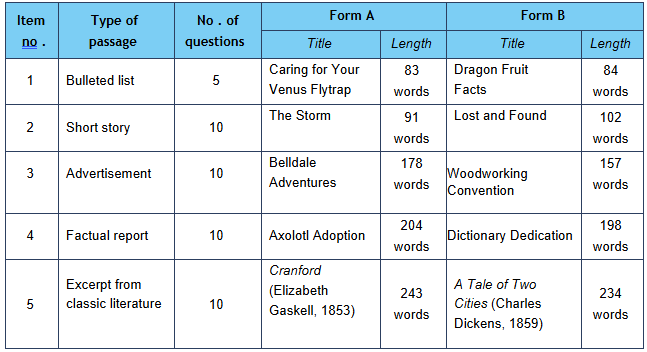Reading comprehension
Each of the two forms of the reading comprehension test comprises five passages of increasing length and difficulty. Each passage is accompanied by a number of multiple-choice questions that demand good literal and inferential reading comprehension skills. The characteristics of each passage are shown in Table 4. Passages in the reading comprehension test.
Table 4. Passages in the reading comprehension test

Each passage is still available when the questions are shown. This is to avoid students having to remember the text, which would confound reading comprehension with memory ability. Some questions have the answer ‘Impossible to say’, which should be selected when the answer cannot be determined or inferred from the information given in the passage.
Note that ‘Impossible to say’ is not equivalent to ‘Don’t know’, which would indicate the student’s inability to deduce the answer, rather than the inherent indeterminacy of the answer; this is explained in the practice phase of the test.
The test begins with a practice item, after which students are allowed a maximum of 10 minutes for the whole test, with no restrictions on the proportions of time spent on the five passages. A timer is visible throughout the duration of the test, so that students can see how long they have left to complete the test. Students are permitted to return to a previous passage if they wish.
Students should be encouraged to work swiftly but conscientiously, and to make a fair attempt at each question. The overall score is designed to reflect careful reading and considered understanding, so students who adopt the tactic of moving on if they cannot immediately determine the answer to a particular question are likely to score rather poorly. Students need to appreciate that they have to think about the questions (as in an examination). Some students may be inclined to automatically click ‘impossible to say’ if they are unable immediately to find the answer to a question within the passage. Students should be made aware that the answer can often be deduced or worked out from the information given in the passage, and that the ‘impossible to say’ option should only be selected when there is insufficient information given in the passage to enable the answer to be deduced.
Students should also be made aware that although the reading comprehension test only lasts 10 minutes, they are not expected to finish it in that time and they should take enough time to get the earlier (easier) questions right. The later passages are quite difficult – the last passage, in particular, will be a significant challenge for students at higher education level – so it is much easier to amass points for answers in the early passages, and students should not rush these.
Results for reading comprehension accuracy and reading comprehension speed are given. The reading comprehension accuracy score is the total number of correct answers given. The program calculates reading comprehension speed by dividing the estimated number of words read in each of the five passages (including the questions) by the time taken to read each passage and answer the associated questions. ‘Dubious’ or ‘aberrant’ cases – i.e. students who simply select answers at random without reading or giving proper consideration to the passages – are flagged up by the program as statistical ‘outliers’, and drawn to the attention of the administrator. These cases tend to have suspiciously high reading comprehension speed but low reading comprehension accuracy.

